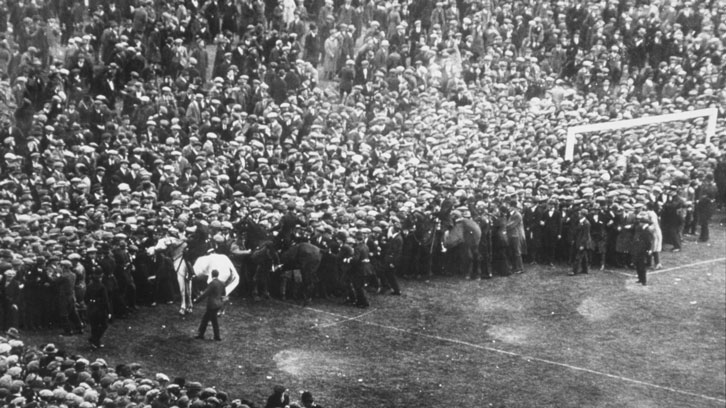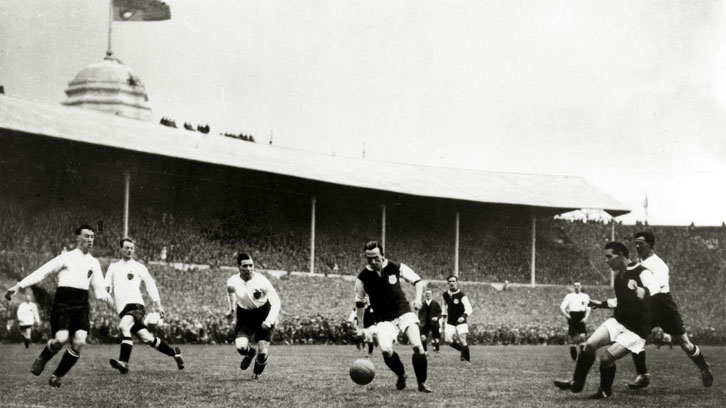
It may seem out of the ordinary to list a defeat among West Ham United’s #50GreatestMatches, but the 1923 FA Cup final was no ordinary match.
The final, which saw the Hammers take on Bolton Wanderers, was the first to be played at the newly completed Empire Stadium in Wembley.
Built in just 300 days at a cost of £750,000 for the British Empire Exhibition of 1924-25, the 127,000-capacity venue was completed just four days before the FA Cup final, which took place on 28 April 1923.
Rather than sell tickets in advance, the Football Association allowed supporters to turn up on the day and pay on the turnstiles. This proved to be a major mistake as an estimated 240,000 fans turned up, with tens of thousands more locked outside.

Nearly a century later, the 1923 FA Cup final is believed to have attracted the highest ‘non-racing’ sporting event attendance in history, far in excess of the official 126,047 supporters who were reportedly present.
With so many supporters inside the stadium bowl, many spilled onto the track surrounding the pitch, and eventually onto the pitch itself, delaying the kick-off by 45 minutes and putting the match under threat.
Mounted police were required to clear the playing surface and a grey horse named Billy and his rider, PC George Scorey, took centre stage, slowly and carefully clearing the thronging crowds from the playing surface and enabling the game to kick-off.
Due to their actions, the match has since been known as ‘The White Horse final’, while the scenes led to a debate in the House of Commons and the introduction of extra safety measures at future finals.
As for the match itself, within two minutes First Division Bolton had taken the lead against their Second Division opponents from east London, with David Jack scoring the first goal in Empire Stadium history, albeit with West Ham’s half-back Jack Tresadern entangled in the crowd lining the touchline.
West Ham were no pushovers, however. Syd King’s Irons had defeated Hull City, Brighton & Hove Albion, Plymouth Argyle and Southampton (after two replays) before thrashing Derby County 5-2 in the semi-finals to reach Wembley.
Already on course for promotion from the Second Division for the first time, King’s team included outstanding players such as goalkeeper Ted Hufton, full-back Ted Henderson, captain George Kay, his fellow half-back Tresadern and forwards Billy Brown, Vic Watson, Billy Moore and Jimmy Ruffell.
After a short suspension of play when the crowd again encroached onto the pitch, West Ham went in search of an equaliser, with Welsh forward Dick Richards being denied by Bolton goalkeeper Dick Pym.
At half-time, unable to return to their dressing rooms due, the two teams remained on the pitch before kicking-off the second half after a break of just five minutes.

West Ham started the second period brightly, but the usually reliable Watson missed a chance and, on 53 minutes, Bolton doubled their lead in highly controversial circumstances.
Not only did West Ham claim Jack Smith’s shot had hit the post, rather than enter the net and hit a spectator, but that the ball had been kicked to Trotters player Ted Vizard by a fan on the touchline in the lead-up to the goal.
Referee David Asson, who later denied Kay’s request to abandon the match, waved away West Ham’s appeals and awarded Bolton’s second goal.
With the pitch in a terrible state following the pre-match trampling by thousands of fans and the police horses, the Hammers were unable to play their normal free-flowing football, with trainer Charlie Paynter lamenting afterwards: “It was that white horse thumping its big feet into the pitch that made it hopeless. Our wingers were tumbling all over the place, tripping up in great ruts and holes.”
West Ham were defeated, but they had been part of an event that will forever be part of British sporting history.
